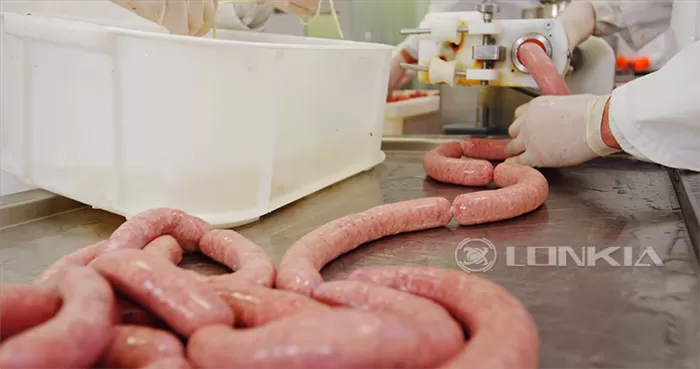In sausage production, the smoking and cooking process plays a vital role in shaping the final product's taste, texture, appearance, and shelf life. These processes are integral to ensuring the safety, flavor, and quality of sausages. Whether you're making fresh sausages, smoked sausages, or cooked sausages, understanding how these processes work within a production line can help improve the quality of your product and increase overall efficiency.
This blog will break down the key aspects of smoking and cooking in sausage production, highlighting the importance of these processes and how they contribute to the final product.
1. The Role of Smoking in Sausage Production
Flavor Development
Smoking is one of the most important techniques for flavor enhancement in sausage production. The process involves exposing sausages to wood smoke, which imparts a distinctive smoky flavor while also adding to the sausage’s color and aroma. Depending on the type of wood used, the smoke flavor can vary, offering different taste profiles that can appeal to diverse consumer preferences.
How Smoking Works in Production:
- Smoking chambers or smokehouses are used to expose sausages to the smoke.
- The sausages are hung or placed on racks, where warm smoke circulates around them.
- The heat and smoke penetrate the sausages, imparting flavor, while also drying the surface to form a protective layer.
Preservation and Shelf Life
The smoking process helps preserve sausages by inhibiting the growth of bacteria and mold, which is critical for extending shelf life. The antimicrobial properties of the smoke act as a natural preservative, which is especially beneficial for dried or cured sausages.
Benefits of Smoking:
- Enhanced flavor and aroma
- Improved preservation through antimicrobial properties
- Color and texture improvement
- Increased shelf life for certain sausage varieties

2. The Importance of Cooking in Sausage Production
Ensuring Food Safety
Cooking is a critical step in ensuring that sausages are safe to eat by destroying harmful bacteria such as Salmonella, Listeria, and E. coli. This is particularly important for sausages made with raw meat, as the cooking process brings the internal temperature to levels that make them safe for consumption.
How Cooking Works in Sausage Production:
- Cookers or steam ovens are used to heat sausages to the desired temperature.
- The sausages are either cooked with direct heat or indirect heat, depending on the equipment used.
- The internal temperature of sausages should be brought to at least 160°F (71°C) to ensure the destruction of bacteria.
Texture and Consistency
Cooking not only ensures the sausages are safe but also impacts their texture and moisture content. The cooking process helps set the sausage's texture by cooking the proteins and fats, leading to a firmer, more cohesive product. If cooked at too high a temperature, however, sausages can become dry, which is why temperature control is crucial.
Benefits of Cooking:
- Kills harmful bacteria and pathogens
- Improves texture and mouthfeel
- Reduces moisture loss to retain juiciness
- Sets the structure of the sausage
3. Cooking and Smoking in Tandem: The Combined Benefits
In modern sausage production lines, smoking and cooking often happen in stages and sometimes simultaneously. This two-pronged approach offers a variety of benefits that improve both the safety and quality of the sausages. By using automated cooking and smoking systems, manufacturers can ensure both processes are handled with precision and efficiency.
Why Combine Smoking and Cooking?
- Consistency: When smoking and cooking are automated, you achieve consistent quality across batches.
- Flavor Enhancement: The combination allows for better flavor integration, as the smoke enhances the taste while the cooking process locks in moisture.
- Time Efficiency: Modern machines like smoke cookers or smoke ovens combine both processes, reducing production time while ensuring the product is fully cooked and flavorful.
4. Choosing the Right Equipment for Smoking and Cooking
The efficiency and quality of your sausage production line rely heavily on the equipment you use. Choosing the right smoking and cooking machines can significantly improve your production output while maintaining product quality.
Key Equipment Features to Consider:
- Temperature Control: Ensure precise temperature regulation to avoid overcooking or undercooking.
- Smoke Circulation: Proper circulation ensures even smoking and flavor distribution.
- Energy Efficiency: Look for machines with energy-efficient designs to save on operational costs.
- Automation: Automated systems for smoking and cooking reduce labor costs and increase consistency.
Types of Equipment:
- Steam Cookers: These are great for retaining moisture and cooking sausages without drying them out.
- Smokehouses/Smoking Chambers: Ideal for sausages that require slow smoking and flavor infusion.
- Combination Ovens: These units allow for both smoking and cooking in one integrated process, improving time and space efficiency.
5. Conclusion: Perfecting Sausage Production with Smoking and Cooking
In sausage production, smoking and cooking are not just add-on steps; they are crucial processes that define the flavor, safety, texture, and shelf life of the product. Understanding how each process contributes to the final product allows manufacturers to fine-tune their production methods and achieve better results.
By utilizing the right equipment, ensuring temperature control, and optimizing the smoking and cooking processes, you can produce high-quality sausages that meet consumer expectations and food safety standards.
At LONKIA Machinery, we provide top-of-the-line equipment to help streamline your sausage production process, including advanced smoking and cooking systems designed for commercial use. Contact us today to find the perfect solution for your production needs!
